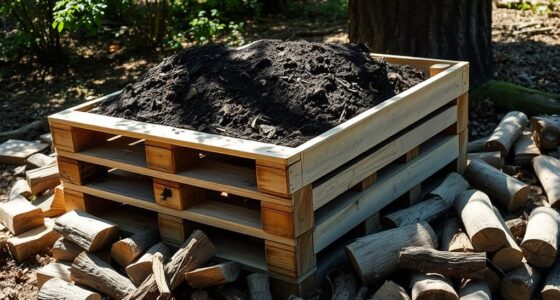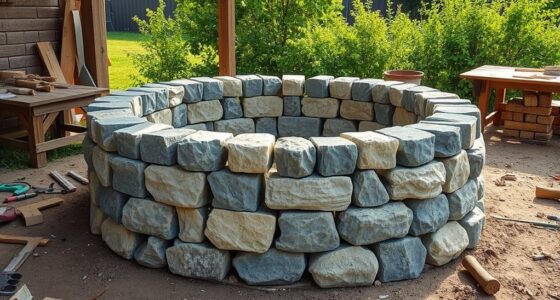To build an IBC-tote firewood cage safely, choose a well-ventilated outdoor spot away from structures and flammable materials. Use durable, rust-resistant materials like galvanized steel or heavy-duty wire mesh, guaranteeing all joints are sealed and corners smoothed. Incorporate a sturdy frame to support stacked wood, and include a secure lid to keep debris out. Regularly inspect and maintain your cage to ensure safety and durability—keep these tips in mind to create a reliable, safe firewood storage solution.
Key Takeaways
- Select a well-ventilated outdoor location away from structures and combustible materials.
- Use durable, rust-resistant materials like galvanized steel or heavy-duty wire mesh for construction.
- Build a sturdy frame with reinforced supports to handle stacked firewood safely.
- Incorporate a secure lid and proper airflow to keep firewood dry and prevent pests.
- Regularly inspect and maintain the cage to address rust, damage, or safety hazards promptly.

Building an IBC-tote firewood cage is a practical way to keep your firewood organized, dry, and easily accessible. When constructing this cage, prioritizing fire safety is essential. You want to ensure that your firewood is stored away from your home or any structures that could be at risk if embers or sparks escape. Position the cage in a well-ventilated outdoor area, away from overhanging branches, combustible materials, or areas prone to flooding. Keep the firewood stack neat, avoiding excessive accumulation that could lead to tripping hazards or make it difficult to access your wood safely. Incorporating a sturdy frame and secure lid helps contain the firewood, minimizes debris, and prevents animals from nesting inside, all of which contribute to safer storage.
Material durability plays a critical role in the longevity and safety of your firewood cage. Choose materials that can withstand the elements, such as galvanized steel, heavy-duty wire mesh, or treated wood. Galvanized steel, for instance, resists rust and corrosion, ensuring your cage remains sturdy over time despite exposure to rain, snow, or humidity. The wire mesh should have a small enough gauge to prevent pests from entering but still allow proper airflow to keep your firewood dry. Avoid cheap or flimsy materials that can warp, break, or degrade quickly, as this compromises both safety and the effectiveness of the storage. Properly sealed joints and corners will prevent sharp edges that could cause injuries, and reinforced supports will handle the weight of stacked firewood without collapsing. Additionally, regular maintenance and inspections are vital to identify and address any early signs of deterioration, ensuring ongoing safety and durability.
Frequently Asked Questions
Can I Customize the Size of the Firewood Cage?
Yes, you can customize the size of your firewood cage. You’ll need to take into account your desired firewood dimensions and available space. Customization options include adjusting the height, width, and length to fit your needs. Just make certain your modifications maintain stability and proper ventilation. Measure carefully and plan your design to ensure it’s functional and safe, making your firewood storage perfectly suited to your space and firewood size.
What Tools Are Needed for Assembly?
You’ll need basic tools like a power drill, screwdriver, and adjustable wrench to assemble your firewood cage. These tools help you secure the panels properly, ensuring good firewood stacking and cage stability. Make sure to follow the instructions carefully, tightening all bolts and brackets firmly. Proper assembly prevents collapse or shifting, keeping your firewood safe and organized. Regularly check the connections to maintain cage stability over time.
How Do I Prevent Rust on the Cage?
To prevent rust on your firewood cage, you might think a little moisture is no big deal—until it turns your sturdy cage into a rusty relic. Use rust prevention techniques like applying a good primer and rust-resistant coating options, such as oil-based paint or specialized metal sealants. Regularly inspect and touch up any chips or scratches, keeping your cage looking sharp and resisting the elements longer.
Is It Safe to Store Other Materials in the Cage?
Storing other materials in the cage isn’t recommended because it can compromise fire safety. Keep it designated for firewood only, as mixed storage might increase fire risks or cause hazardous reactions. Follow proper storage tips, like keeping combustible items separate and avoiding flammable liquids nearby. Always prioritize fire safety by maintaining a clean, organized cage and regularly inspecting for any potential hazards to ensure safe storage practices.
How Often Should I Inspect the Cage for Damage?
You should inspect your firewood cage regularly, ideally during seasonal maintenance, to catch damage indicators early. Check for rust, corrosion, loose fittings, or bent frames. Examine welds and joints for cracks or wear, and look for signs of pests or mold. By inspecting your cage at least seasonally, you’re ensuring its integrity, safety, and longevity, preventing accidents and maintaining a sturdy enclosure for your firewood.
Conclusion
Now that you’ve built your IBC-tote firewood cage, you’ve created a sturdy fortress for your logs, turning chaos into order. Think of it as a trusted guardian, keeping your firewood dry and ready to ignite warmth and comfort. With each carefully placed plank, you’ve woven safety and convenience into your outdoor space. Your effort transforms simple materials into a sanctuary, where crackling flames will dance safely, lighting up your evenings like a beacon of warmth and home.









